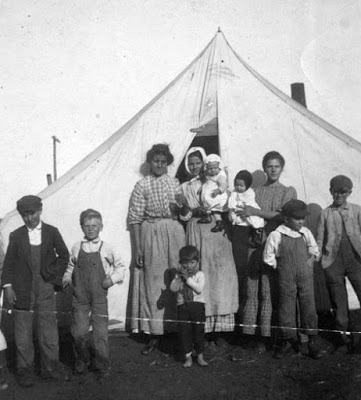I found that Frank Little, subject of my first book Frank Little and the IWW: The Blood That Stained an American Family, often spoke of Ludlow in his last years. His final words regarding the Colorado coal miners’ tent colony were on July 20, 1917, during a fiery speech at Finn Hall in Butte, Montana. Immigrant women and children had suffocated and burned in a pit below a tent where they were hiding from Colorado National Guard’s Gatling gunfire in the 1914 attack. Frank was murdered for his words on August 1, 1917
Frank had been addressing a group of mine workers and others he ascertained to be “prostitutes of the press,” that is, reporters who had been contributing to a narrative against the Butte Metal Mine Workers Union’s strike.
He reminded miners that Rockefeller-employed train engineers and brakemen, members of the AFL, had carried Colorado National Guardsmen and company-hired gunmen to Ludlow to punish a coal miners’ strike against a Rockefeller-owned Colorado Coal and Iron Company. No true union man would have done that, he declared.
Afterwards, famous rebel-girl Elizabeth Gurley Flynn went even further, expressing deep disappointment in Colorado’s women, who sympathized with the mining company. She expected better of them—all mothers, wives, and daughters should have protested in a loud voice against the Ludlow episode. Now as I write Jane Street and the Rebel Maids, about a young woman who went up against the ladies of Denver’s Capitol Hill–some of whom sided with the militia’s thugs, I understand Mary Harris Jones’s statement
“God almighty made women and the Rockefeller gang of thieves made the ladies.”
Typical of labor events during this period, the ensuing deaths became called a “massacre.” My husband and I had been to Ludlow long before I began either book project. With Frank’s words, I wanted to know more.
I was already schooled about labor conflicts involving coal miners on Colorado’s Front Range. My Danish great-grandmother Peterson had married a second time to a Frenchman named Julian Gradel. Gradel had been a political heavyweight and a mine superintendent in Louisville, Colorado. He and my great-grandmother lived among other French and Italian immigrants in a solidly middle-class neighborhood. He was mine management, and they owned their home. Still, there had been multiple labor conflicts in Louisville over intolerable working and living conditions, unacceptable wages, company-hired thugs, union recognition, and martial law.
In 1910, the longest coal strike in Colorado history began, and miners in the Northern Coal Fields, where Louisville sat, were to be out of work almost five years. By 1913, coal miners statewide were on strike, including those in Ludlow.

One week after the Ludlow Massacre, on April 27, 1914, thousands of shots were fired in Louisville. One man was killed, and federal troops were called in. But my step-great-grandfather was already dead from a gunshot wound, though it had been accidentally self-inflicted three years earlier.
Unlike Louisville, Ludlow had been a tent colony of 1200, primarily poor Mexican and Italian immigrant mine workers and their families who had been forced out of their company houses. The camp was located about 18 miles northwest of Trinidad and about 25 miles south of Walsenburg, a historical town best known for its infamous inhabitant, Jesse James’ murderer, Robert Ford.
During a fourteen-hour standoff between hired strike breakers and the Colorado National Guard against the miners, a Gatling gun atop a hill fired thousands of shots into the camp. Women and children fled to their tents—and the cellars dug below them—for protection. After the gunfire ended, among the dead were two women and eleven children who had asphyxiated and burned below their fired tent. Bodies of two miners were displayed near the railroad tracks as a warning to other workers who might consider striking.
John D. Rockefeller claimed no responsibility for the deaths, stating there was no Ludlow massacre. He claimed the engagement started as a desperate fight for life by two small squads of militia against the entire tent colony. Decades later archaeological evidence reveals otherwise.
A monument of a man, woman, and child, in memory of the miners and their families who died that day, looms over the cellar where the women and children died. When my husband and I visited, the white-stone figures were missing their heads, a desecration to their memory, and the cellar’s maw was unsettling. Today all have been restored. Although the United Mine Workers of America own the site, the Ludlow Massacre, a watershed event in labor history, has been designated a National Historical Landmark.
As a final aside, Mother (Mary Harris) Jones, the widow of a miner, is well-known for supporting the miners and their families during the Colorado coal miners’ strike. The folk song, “She’ll Be Coming Around the Mountain,” has been attributed to her travels among mining camps, though the original version was an old Southern spiritual titled, “When the Chariot Comes.”